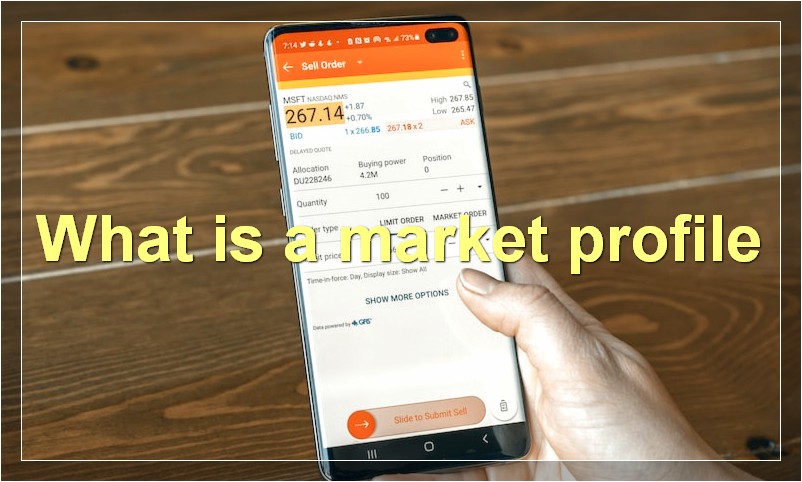A market profile can help traders identify trading opportunities by providing them with a comprehensive view of the market. By understanding the market’s supply and demand, traders can make informed decisions about where to enter and exit trades.
What is a market profile

If you’re new to trading, you may have come across the term “market profile.” But what is a market profile?
In short, market profile is a way of representing the distribution of prices in a market over a given period of time. It’s often used by traders to get an idea of where price is likely to find support and resistance.
Market profile can be thought of as a “picture” of the market. It’s created by plotting the price of a security at specific intervals throughout the day. This gives traders a visual representation of how the market is trading at different times of the day.
Market profile can be used on any time frame, but it’s most commonly used on intraday charts. This is because intraday price action is more volatile and tends to move in shorter-term cycles than price action on longer-term time frames.
There are a few things that traders look for when using market profile:
1. Value areas: These are areas where the market has traded at or near the same price for a significant period of time. Traders will often use these areas as potential support and resistance levels.
2. Point of control: This is the price level at which the most volume has been traded. The point of control can be thought of as the “center” of the market profile.
3. High-volume nodes: These are areas where there has been a significant amount of trading activity. High-volume nodes can be used as potential support and resistance levels.
4. Low-volume nodes: These are areas where there has been very little trading activity. Low-volume nodes can sometimes be used as potential support and resistance levels, but they’re not as reliable as high-volume nodes.
5. Price extremes: These are the highest and lowest prices that have been traded during the period that the market profile is based on. Price extremes can be used as potential support and resistance levels.
How is a market profile used in trading
When it comes to trading, market profile can be a helpful tool in identifying potential areas of support and resistance. This is because market profile provides traders with a visual representation of where price has been trading throughout the day. By looking at the market profile, traders can get a better sense of where buyers and sellers are likely to step in and make trades. Additionally, market profile can also be used to help identify possible areas of price discovery.
What are the benefits of using a market profile
There are many benefits of using a market profile, including gaining a better understanding of the market, identifying potential opportunities and risks, and making more informed decisions.
A market profile can help you to:
• better understand how the market works
• identify potential opportunities and risks
• make more informed decisions about buying or selling securities
• monitor your portfolios and strategies
How can a market profile help traders identify trading opportunities
A market profile is a graphical representation of price action in a market. It shows the distribution of prices over time, and can provide traders with valuable information about market activity and potential trading opportunities.
Market profiles can be used to identify patterns of market activity, such as areas of support and resistance, and to gauge the level of activity in a market. They can also be used to assess the strength of trends, and to identify potential reversals.
Market profiles can be created for any time frame, from intraday charts to monthly charts. They can be used on their own or in conjunction with other technical indicators.
What information does a market profile contain

A market profile contains a wealth of information about a given market, including its size, growth potential, key players, and major trends. This information can be used by businesses to make informed decisions about where to invest their resources. Additionally, market profiles can be useful for individuals who are considering entering a particular market. By understanding the key characteristics of the market, they can make more informed decisions about whether or not it is the right fit for them.
How is a market profile created
A market profile is created by analyzing the supply and demand in a market. This can be done by looking at the number of buyers and sellers, the prices they are willing to pay or sell for, and the quantity of goods being traded. This information can be used to create a model of how the market works, which can then be used to make predictions about future market behavior.
How often is a market profile updated
A market profile is a tool used by traders to give them an insight into the current market conditions. It is updated on a daily basis and gives information on the open, high, low and close prices for the day as well as the volume traded. This information can be used by traders to make decisions on where to enter and exit the market.
What factors can affect a market profile
There are many factors that can affect a market profile. The most obvious factor is the supply and demand of the products or services in the market. Other factors include the price of related goods and services, the availability of substitutes, and the income level of consumers. Additionally, government policies, such as taxes and subsidies, can also influence the market profile.
Does a market profile always accurately reflect the market conditions
A market profile is a graphical representation of trading activity over a period of time. It shows the distribution of price levels at which transactions have occurred. The market profile can be used to identify trading opportunities and assess market conditions. However, it is important to note that the market profile is not always accurate and should be used in conjunction with other indicators.

